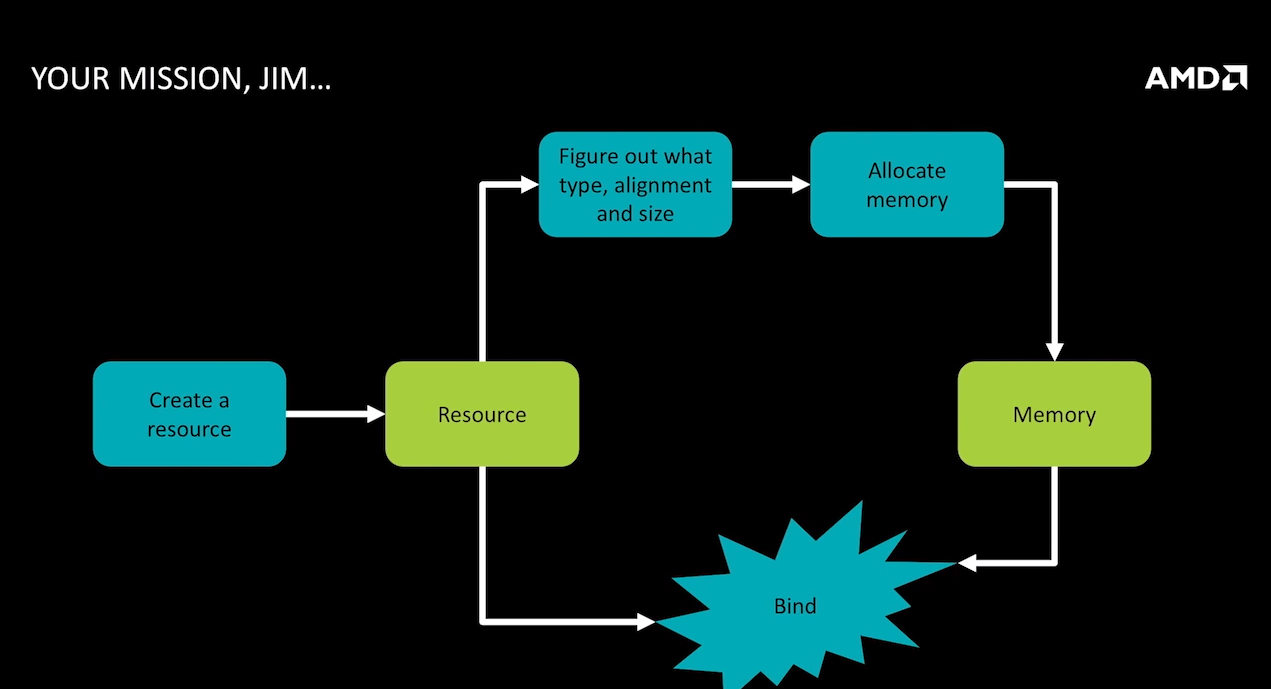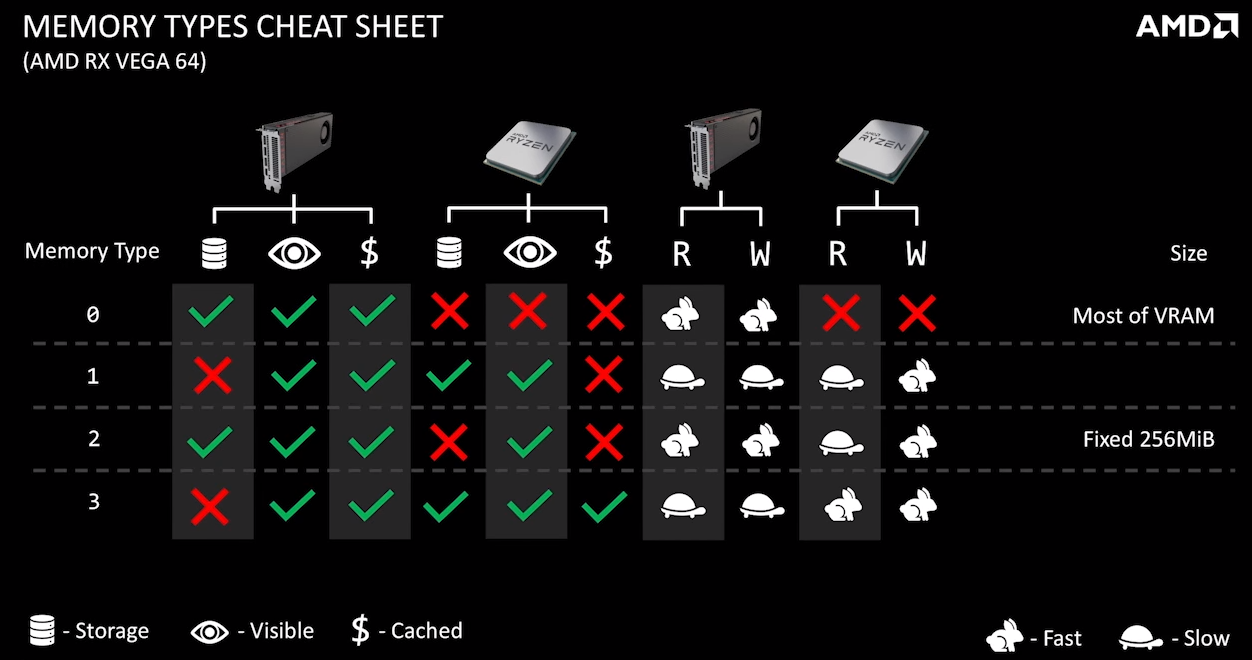Vulkan Device Memory
1、通过下面的接口,可以获得显卡支持的所有内存类型;

MemoryType的类型如下:

2、引用索引3对内存的描述
我们可以通过调用
vkGetPhysicalDeviceMemoryProperties查询应用可使用的内存。它会返回请求大小的一个或多个内存堆,或者请求属性的一种或多种内存类型。每种内存类型来自于一个内存堆 - 因此,一个典例就是PC上的一个独立显卡将会有两个堆 - 一个是系统内存,另一个是GPU内存,并且他们各自拥有多种内存类型。内存类型有不同属性。一些内存可以被CPU访问或者不行、GPU和CPU访问一致、有缓存或者无缓存等等。通过调用vkAllocateMemory()可以分配内存,但它需要VkDevice句柄和描述结构体。HostVisibleMemory是可以通过Map方式来完成数据的更新的(vkMapMemory()/vkUnmapMemory())。GL使用者应该熟悉这个概念,但解释给D3D11的用户,vkMapMemory返回的指针可以被hold住被CPU写入当GPU正在使用它们。这些持久化的映射是完全正确的只要你遵守规则并且确定同步了内存访问。
3、VkMemeoryFlagBits
typedef enum VkMemoryHeapFlagBits { VK_MEMORY_HEAP_DEVICE_LOCAL_BIT = 0x00000001, VK_MEMORY_HEAP_MULTI_INSTANCE_BIT = 0x00000002, VK_MEMORY_HEAP_MULTI_INSTANCE_BIT_KHR = VK_MEMORY_HEAP_MULTI_INSTANCE_BIT, VK_MEMORY_HEAP_FLAG_BITS_MAX_ENUM = 0x7FFFFFFF } VkMemoryHeapFlagBits;
VK_MEMORY_HEAP_DEVICE_LOCAL_BIT specifies that the heap corresponds to device local memory.
Device local memory may have different performance characteristics than host local memory,and may support different memory property flags.
• VK_MEMORY_HEAP_MULTI_INSTANCE_BIT specifies that in a logical device representing more than one
physical device, there is a per-physical device instance of the heap memory. By default, an allocation from such a heap will be replicated to each physical device’s instance of the heap.
4、MemoryTypeFlags
typedef enum VkMemoryPropertyFlagBits { VK_MEMORY_PROPERTY_DEVICE_LOCAL_BIT = 0x00000001, VK_MEMORY_PROPERTY_HOST_VISIBLE_BIT = 0x00000002, VK_MEMORY_PROPERTY_HOST_COHERENT_BIT = 0x00000004, VK_MEMORY_PROPERTY_HOST_CACHED_BIT = 0x00000008, VK_MEMORY_PROPERTY_LAZILY_ALLOCATED_BIT = 0x00000010, VK_MEMORY_PROPERTY_PROTECTED_BIT = 0x00000020, VK_MEMORY_PROPERTY_DEVICE_COHERENT_BIT_AMD = 0x00000040, VK_MEMORY_PROPERTY_DEVICE_UNCACHED_BIT_AMD = 0x00000080, VK_MEMORY_PROPERTY_FLAG_BITS_MAX_ENUM = 0x7FFFFFFF } VkMemoryPropertyFlagBits;
VK_MEMORY_PROPERTY_DEVICE_LOCAL_BIT bit specifies that memory allocated with this type is the most efficient for device access. This property will be set if and only if the memory type belongs to a heap with the VK_MEMORY_HEAP_DEVICE_LOCAL_BIT set.
• VK_MEMORY_PROPERTY_HOST_VISIBLE_BIT bit specifies that memory allocated with this type can be mapped for host access using vkMapMemory.
• VK_MEMORY_PROPERTY_HOST_COHERENT_BIT bit specifies that the host cache management commands vkFlushMappedMemoryRanges and vkInvalidateMappedMemoryRanges are not needed to flush host writes to the device or make device writes visible to the host, respectively.
• VK_MEMORY_PROPERTY_HOST_CACHED_BIT bit specifies that memory allocated with this type is cached on the host. Host memory accesses to uncached memory are slower than to cached memory,however uncached memory is always host coherent.
• VK_MEMORY_PROPERTY_LAZILY_ALLOCATED_BIT bit specifies that the memory type only allows device access to the memory. Memory types must not have both
VK_MEMORY_PROPERTY_LAZILY_ALLOCATED_BIT and VK_MEMORY_PROPERTY_HOST_VISIBLE_BIT set.Additionally, the object’s backing memory may be provided by the implementation lazily as specified in Lazily Allocated Memory.
• VK_MEMORY_PROPERTY_PROTECTED_BIT bit specifies that the memory type only allows device access to the memory, and allows protected queue operations to access the memory. Memory types must not have VK_MEMORY_PROPERTY_PROTECTED_BIT set and any of VK_MEMORY_PROPERTY_HOST_VISIBLE_BIT set, or VK_MEMORY_PROPERTY_HOST_COHERENT_BIT set, or VK_MEMORY_PROPERTY_HOST_CACHED_BIT set.
• VK_MEMORY_PROPERTY_DEVICE_COHERENT_BIT_AMD bit specifies that device accesses to allocations of this memory type are automatically made available and visible.
• VK_MEMORY_PROPERTY_DEVICE_UNCACHED_BIT_AMD bit specifies that memory allocated with this type is not cached on the device. Uncached device memory is always device coherent.
5、Host memory is memory needed by the Vulkan implementation for non-device-visible storage.This memory may be used to store the implementation’s representation and state
of Vulkan objects.
6. Device memory is memory that is visible to the device — for example the contents of the image or buffer objects, which can be natively used by the device.
Device coherence is a useful property for certain debugging use cases (e.g. crash analysis, where performing separate coherence actions could mean values are not
reported correctly). However, device coherent accesses may be slower than equivalent accesses without device coherence, particularly if they are also device
uncached. For device uncached memory in particular, repeated accesses to the same or neighbouring memory locations over a short time period (e.g. within a
frame) may be slower than it would be for the equivalent cached memory type. As such, it’s generally inadvisable to use device coherent or device uncached memory
except when really needed.
7.






VulkanMemoryAllocator Github 提供了一个专门针对vulkan内存管理的库。
Reference
2、https://gpuopen.com/vulkan-device-memory/
5、Vulkanised 2018 - Memory Management in Vulkan


 浙公网安备 33010602011771号
浙公网安备 33010602011771号